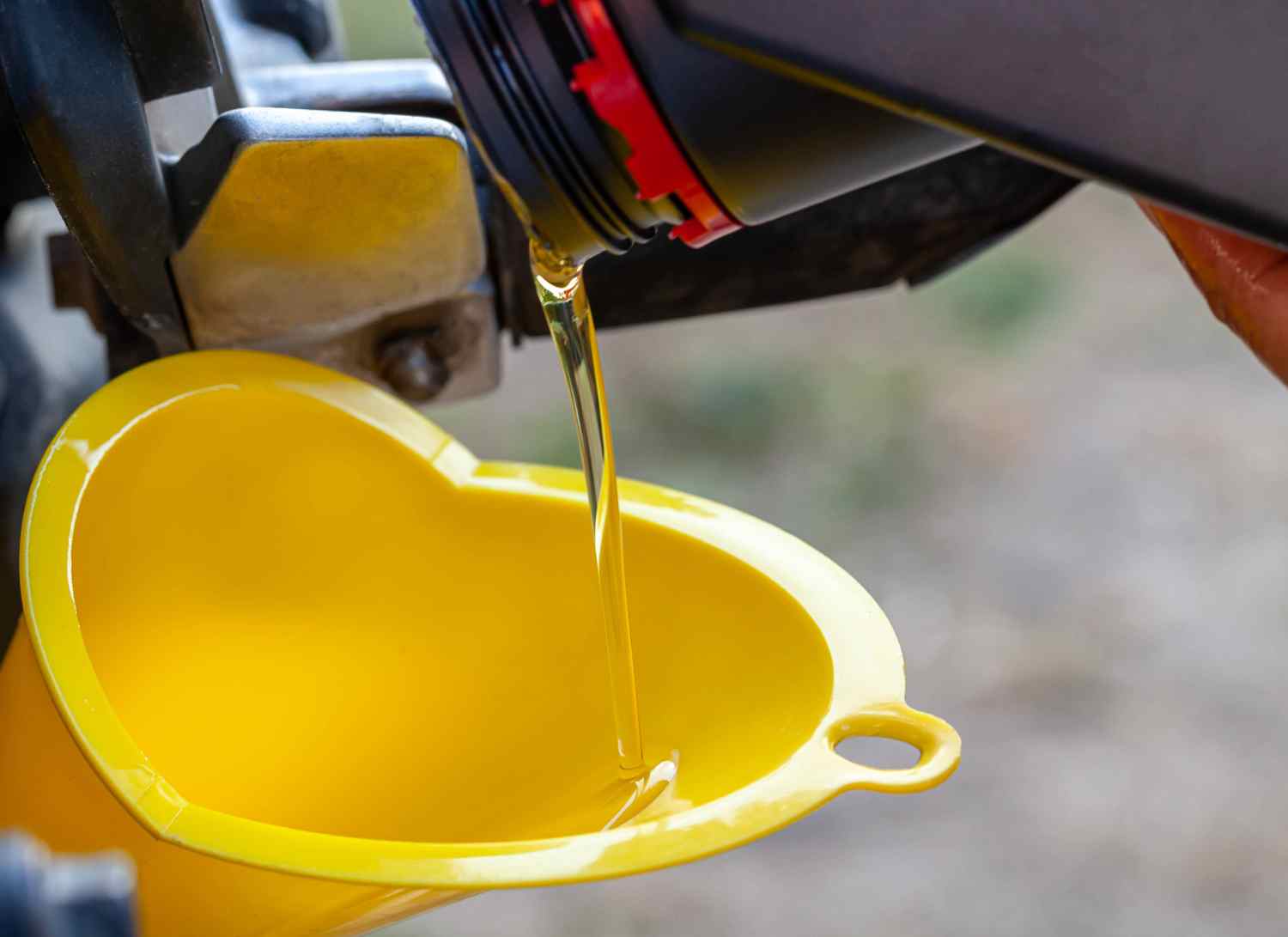What is Hydraulic Oil?
Hydraulic oil is also referred to as hydraulic fluid. It is a non-compressible fluid utilised to transfer power in hydraulic machinery and equipment. It can also be used as a coolant, sealant, and lubricant within equipment and machinery parts.
Contents of Hydraulic Oil
Hydraulic oil is composed of several different ingredients mixed based on the required oil type. In general, hydraulic oil consists of:
- Ethers
- Esters
- Glycol
- Mineral oil
- Silicone
Properties of a Good Hydraulic Fluid
The following characteristic properties of hydraulic oil ensure the proper operational working of your hydraulic system:
- Anti-wearing
- Constant viscosity
- Cost-effective
- Fire resistance
- Long-lasting
- Low tendency to cavitate
- Non-compressibility
- Non-corrosiveness
- Non-volatile
- Stable
- Thermal stability
- Water tolerance

Classification of Hydraulic Oil
Based on varying levels of performance, the hydraulic oil is classified as:
- HL (Anti-oxidant and anti-rust)
- HM – HL (Anti-wear)
- HR – HL (VI improver oil)
Physical Properties of a Hydraulic Oil
Temperature Range of Hydraulic Oil
Hydraulic fluid is thermally stable, which helps retain its properties in a specific temperature range. The additives and hydraulic oil blend make it fit for using in both hot and cold conditions. Otherwise, high heat can lead to hydraulic oil deterioration.
Hydraulic Oil Viscosity
Viscosity is the measurement of hydraulic oil’s flow resistance. It indicates that the oil can resist compression at different rates. High viscous hydraulic fluid is thicker and more difficult to compress, and low viscous hydraulic oil is comparatively thinner and quickly moves.
The hydraulic fluid’s viscosity is usually measured at 40°C to 100°C in the unit Centistokes (cSt). Hydraulic oil of different viscosity is used for different purposes because the wrong viscous fluid can damage the equipment or lead to poor functioning results.
Viscosity Index (VI)
The viscosity index measures the hydraulic oil’s viscosity when the temperature changes. The impact of temperature change is more on low viscosity index hydraulic oil than high viscosity index hydraulic oil.
The Society of Automotive Engineers (SAE) has developed a Viscosity Index Scale, presenting low to high viscosity levels based on different temperature ranges. It includes:
- Low viscosity (0 – 35°C)
- Medium viscosity (35 – 80°C)
- High viscosity (80 – 110°C)
- Very high viscosity (110°C and greater)

Relationship of Temperature and Viscosity of Hydraulic Oil
There is a direct link between hydraulic oil’s temperature and viscosity. The oil is less viscous at high temperatures and more viscous at lower temperatures.
Flash Point of Hydraulic Oil
It is the minimum temperature where the liquid releases enough combustible vapours to create a flash. The flash point for hydraulic oil is 135°C and the fluid must be kept below this temperature for avoiding risks and dangers of ignition.
Uses of Hydraulic Oil
Hydraulic oil is an essential fluid that has extensive uses across different industries:
- It is used in forklift trucks and stackers, delivering power to the robust forks for lifting super heavy goods.
- It powers the log splitters (wood splitters) to split logs easily.
- It aids the immense power range of automotive lifts, ensuring their safety and optimum performance.
- It is utilised in the wright standers on mowers, ensuring their good performance for cemeteries and grassy areas.
- It helps in the robust operation of a snow plough and ploughing equipment, allowing efficient angle, lift, and tilt movements of the snow plough blade. It is blended with anti-freeze additives to ensure effective performance.
- It plays a crucial role to ensure the competent and versatile functioning of the skid steers at all times.
- It is used in aviation control systems, hangar doors, and jacks, ensuring the reliable operations of aircraft.
- It protects the air tools and compressors as an anti-wear additive.
- It ensures the smooth functioning of hydraulic brakes and systems of tractors used for agricultural purposes.
- It stabilises cruise ships and the marine industry, reducing the rolling amount and ensuring the balance of ship.
Additives of Hydraulic Oil
Additives are mixed with the hydraulic oil, allowing it to perform optimally under varying conditions. Some of the additives and their benefits include:
- Anti-Foaming Additives help reduce foaming within the fluid, usually caused by detergents and maintain the product quality.
- Anti-Freeze Additives prevent the freezing up or waxing of fluid during low temperatures or icy conditions.
- Anti-Oxidant Additives enhance the hydraulic fluid’s usage period without needing oil change and reduce sludge deposits.
- Anti-Rust Additives form a protective layer which helps reduce rust damage due to oxygen contact.
- Anti-Wearing Additives prolong the equipment and machinery’s life working under high-pressure environments.
- Cold Flow Additives enable hydraulic oil to function correctly, even during extreme cold days.
Applications of Different Grade Hydraulic Oil
The following classification leads to common ISO-grade hydraulic oils and their uses:
- ISO 100 hydraulic oil is utilised in heavy loads of industrial machinery.
- ISO 68 hydraulic oil is used in significant load-carrying capability systems.
- ISO 46 hydraulic oil is usually needed in high-pressure industrial plant work.
- ISO 32 hydraulic oil is preferred to utilise in high-power requiring machine tools.
- ISO 22 hydraulic oil is usually utilised in airline equipment.
- ISO 15 hydraulic oil is generally utilised in hydraulic brake systems and power steering.

Hydraulic Oil & Hydraulic System
One of the significant applications of hydraulic oil is in the hydraulic systems for transferring power from system’s one part to the other. The oil passes through the hydraulic system when an outside force is applied on the non-compressible hydraulic fluid by the piston within a cylinder. It produces a force on system’s other end, which causes the movement to occur.
Hydraulic Oil and Pumps
Hydraulic fluid ensures the efficient performance of pumps. The right kind of fluid is selected for a pump depending on its type, maximum operating temperature and pressure, and the type of material. The purpose of using it in pumps is because it helps:
- Dissipate heat
- Prevent corrosion
- Provide lubrication
- Transmit energy
Therefore, a poorly matched fluid can cause pump’s calamitous failure, which leads to:
- Compromised system efficiency
- Excess heat generation
- Reduced component life
- Sludge and varnish formation
- Surface erosion and wear
Types of Pumps
The following are three common types of pumps, each working on a different mechanism:
Gear Pumps
These pumps operate by fluid compression between the gear housing inside the wall and meshing gear teeth trapped air volume. They require a maximum temperature of 70°C and 500 psi pressure and work best with the fluid having an ISO VG viscosity of 15-32.
Piston Pumps
These are more complex and can attain pressure levels of almost 500 psi and a temperature of 70°C. They need a fluid viscosity from 15-22.
Vane Pumps
These pumps create vane chambers when rotors with slots are mounted to a shaft, spinning unconventionally to a cam ring. The maximum operating pressure for these pumps is 500psi, and they work optimally with ISO VG fluid of viscosity 15-22.
Types of Hydraulic Fluid
There are three major hydraulic fluid types, each with specific set of properties that make them suitable for certain applications.
Petroleum-based Hydraulic Fluid
It is used more often and is present in various forms based on the processing of petroleum products, such as:
- Group I (produced from solvent-neutral mineral oils)
- Group II (consist of hydro processes base oil)
- Group III (constituted of hydrocracked base oil)
Synthetic Hydraulic Fluid
This type of hydraulic fluid is chemically produced from base oils, providing more fluid stability and lubrication.
Water-based Hydraulic Fluid
This type of hydraulic fluid is usually used when the possibility of fire is a primary concern.
Analysis of Hydraulic Oil and its Importance
Hydraulic oil analysis, also known as condition monitoring, helps assess the hydraulic oil quality before its application. The analysis report provides information on whether the oil is fit for use or needs to be changed. It helps prevent the equipment from damage due to dirty or worn fluid.
These points indicate the necessity of this analysis:
- Enhanced life and performance of machinery.
- Minimised machinery damage with early identification of issues.
- Reduced cost associated with premature oil replacement.
- Reduced damage risk for the machinery products.
- Reduced risk of people injury and other damages costs.
Conclusion
Hydraulic oil has a wide-ranging significant role for commercial purposes, and it is crucial to source high-quality hydraulic oil from a trusted supplier. Moreover, it is also vital to check its chemical compatibility with the seals used in the hydraulic system pumps.










